
# White Papers
The Importance of Low Phase Noise in Mobile Applications
Who Should Read This White Paper?
This white paper is intended for systems integrators and designers of mobile C5ISR
(command, control, communications, computers, cybersecurity, intelligence, surveillance, and reconnaissance) platforms. In addition, technical and non-technical professionals involved with the planning, designing and deployment of PNT systems, such as: systems engineers, communications engineers, applications engineers, defense engineers, contractors and consultants.
The Need
Communications and intelligence-collection functions, traditionally associated with fixed sites and large platforms, are being pushed to tactical vehicles and sophisticated Unmanned Autonomous Vehicles (UAVs). This results in more C5ISR systems being installed on mobile platforms. Signal Intelligence (SIGINT) receivers, Satellite Communications on the Move (SOTM), radars, and communications relay systems – to name just a few – are operating on mobile platforms in demanding environments. Whether in the air, on land, or at sea, these vehicles will impart shocks and vibrations to their electronics, sometimes severely. Traditionally frequency stability drift is the oscillator specification that is most seriously considered by system designers. However, in high vibration environments, the system designer must also account for induced phase noise which can drastically affect overall performance.
The Challenge
In a wireless communication system, for example, the performance of the link – how much
bandwidth it can consistently offer over a given range – will be determined by the power of the transmitter, the sensitivity of the receiver and by the phase noise of both the transmitter’s signal source and the receiver’s local oscillator. Similarly with radars, the ability to detect targets at a given range will be mostly determined by these same four factors. The main difference for monostatic radars is that the transmitter’s signal source and the receiver’s local oscillator are typically the same device. Therefore, in a radar system the advantage of good phase noise in this single oscillator has a double effect.
As radar and communication systems embrace digital processing, the demand on the oscillators increases significantly. A transmitted signal for communications or radars that is transmitted at multiple frequencies and then reassembled must have a stable initial frequency in all environments. Anything that can be done to reduce the phase noise will improve overall performance.
Typical Applications
In the four Typical Applications shown below, the blue signal line illustrates where this reference oscillator is used in a C5ISR system
Satcom on the Move – SotM
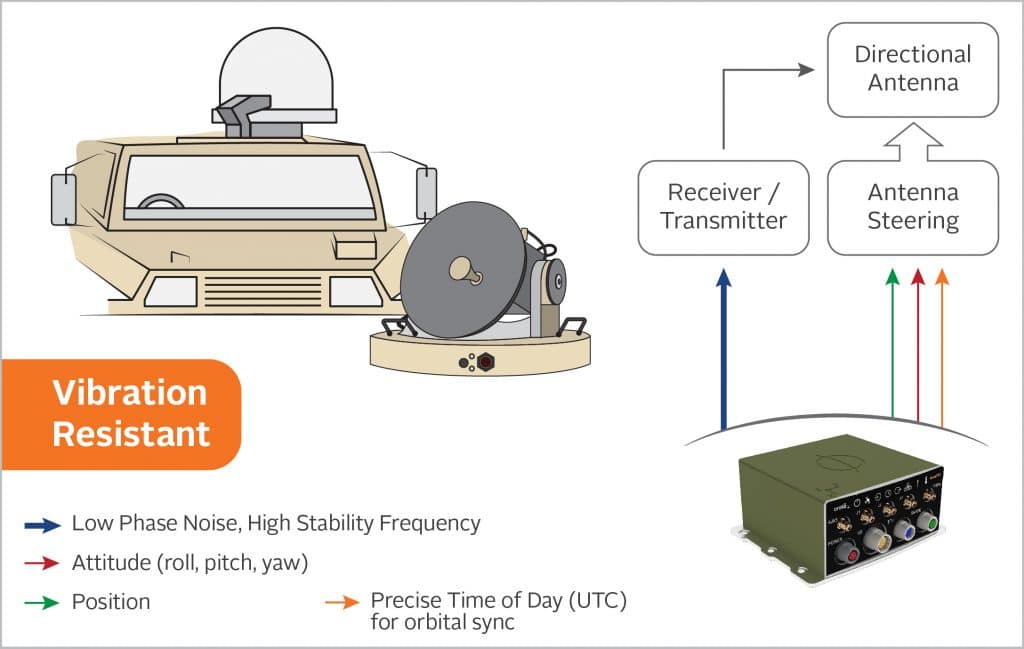
Signal Intelligence/Data Collection Sensor

Airborne Communication Relay
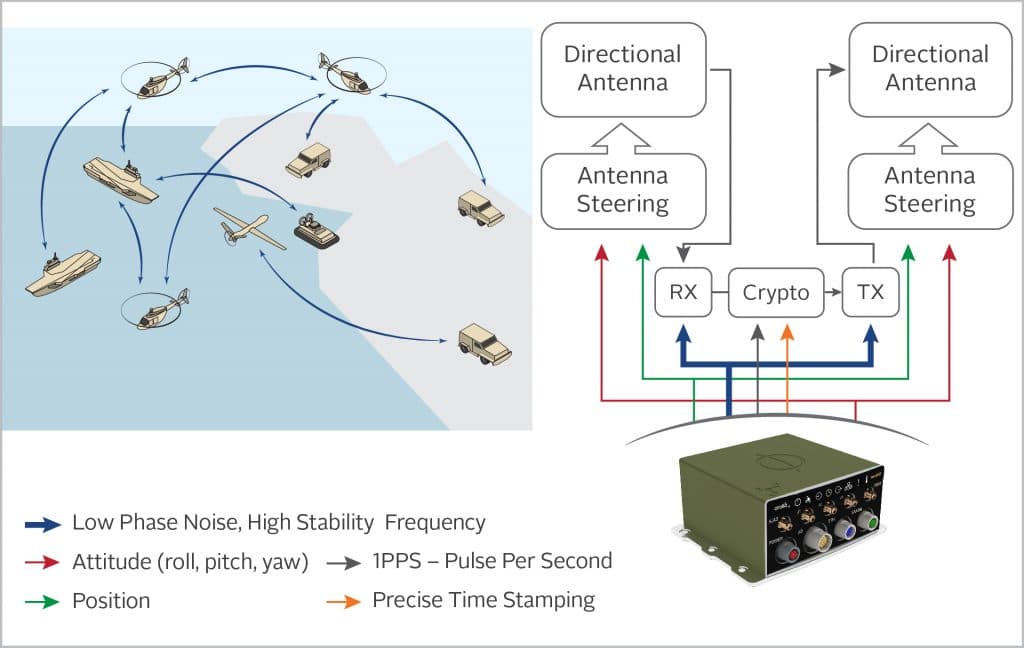
Synthetic Aperture Radar Imagery Sensor
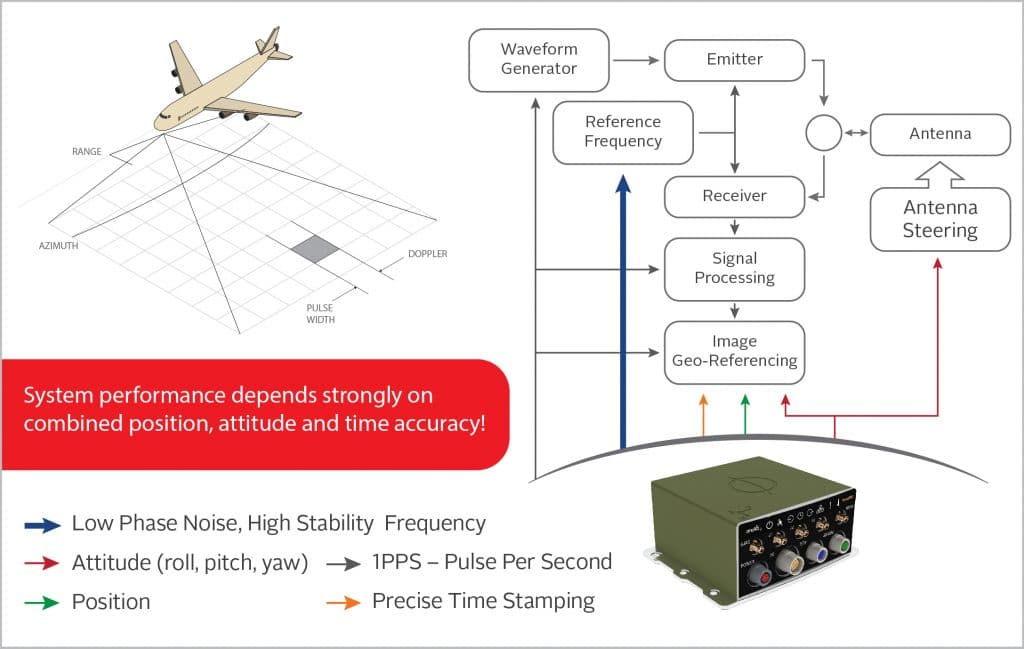
Quartz – a Blessing and a Curse
Most systems use quartz technology for their reference frequency source and local oscillator. Even atomic clocks that provide ultra-stable frequency typically include a quartz oscillator for improved purity of the signal. The uniform molecular crystal structure of quartz provides a very narrow mechanical resonant frequency. As a piezo-electric device, this precise mechanical resonant frequency is transformed into an electric field that, in a properly designed feedback circuit, generates a pure frequency output. Quartz crystals provide the purest frequencies when cut for 5 to 10 MHz generation, with 10 MHz being the most common.
The two environmental factors that most affect the accuracy of the quartz oscillator’s output frequency and noise performance are temperature and vibration. Phase noise is also affected by magnetic fields, which can create issues when attempting to meet extremely low phase noise specifications.
Temperature effects on frequency can be reduced by measuring the temperature variations and electrically tuning the crystal to keep it on frequency. This device is called a Temperature Compensated Crystal Oscillator (TCXO). Further refinement is achieved by placing the crystal oscillator in a temperature-controlled chamber – an Oven Controlled
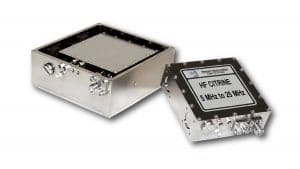
Crystal Oscillator (OCXO). Both are common and used in most wireless systems today.
Recent advances in MEMs technology (Micro Electro-Mechanical devices) provide designers with good quality resonators at very low cost, but quartz continues to be the primary technology selected for overall high performance and stability.
Countering vibration is challenging, especially when using quartz. Quartz naturally turns mechanical/acoustic vibrations into frequency modulation, so we are attempting something unnatural. In fact, if you wanted to build a device that converts mechanical acoustic vibrations into frequency variations – and we have a name for this device, it’s called a microphone – you would use quartz. Thus, trying to isolate mechanical vibrations from quartz to keep its frequency pure is an important and challenging endeavor.
Moving vehicles produce a complex vibration spectrum that is imparted on the electronics,
depending on the mechanical mounting. Some of the energy is random and noise-like. Some of it is concentrated at resonant frequencies generated by the rotation of propellers or fans, engine RPM or the resonant structure of the vehicle’s frame.
Quieting the Noise
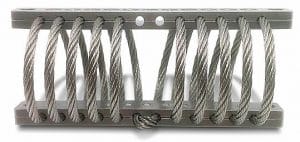
To reduce vibration effects on the electronics and particularly on the frequency source, mechanical isolation using cushions, springs, stiffeners, and dampers absorbs some of the vibration energy above the natural resonant frequency of the mechanical system. These dampers are used in vehicles of all kinds to reduce peak energy or to distribute the energy to frequencies outside the range of interest for the signal source.
The phase noise plots shown below illustrate a typical example of the effects of vibration on the phase noise of a frequency source. On the left is the quiet phase noise from a static quartz oscillator at rest and on the right, the same oscillator installed in a vibration table simulating aircraft movement. Notice the increased noise from 3 – 30 Hz, with a large peak at 20 Hz due to propeller RPM. The mechanical vibrations couple directly into the oscillator’s performance, which in turn will deteriorate the performance of the system it is driving.
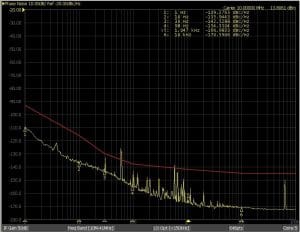
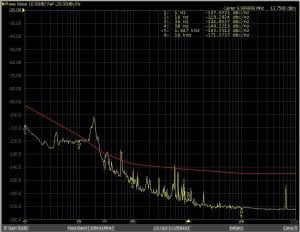
Safran, working with its partner Wenzel Associates, Inc., has devised several solutions to this induced vibration. Safran’s VersaSyncTM – a rugged time and frequency source using GPS disciplining — is available with an optional low noise reference oscillator from Wenzel that is less susceptible to these vibrations. For applications that require both frequency and positioning, VersaPNT provides full functionality; for applications that have fewer constraints on Size, Weight and Power (SWaP) but need the best phase noise performance, Safran’s SecureSync® rack-mount system is appropriate. In this configuration, multiple oscillators with noise cancelling and atomic clock holdover are available, as well as customized designs that will null out resonant peaks.
The Next Steps
This often-neglected factor – phase noise induced by vehicle vibration – can be a major system performance driver and often it goes undetected until the first flight test. The problem is not limited to just aircraft, but is present for any moving vehicle – land, sea or air – or even in fixed site applications near rail lines, industrial equipment or any acoustically noisy or vibrating environments. Don’t be caught off guard. Safran delivers solutions that keep low noise signals pure in any environment. Working with our partner Wenzel, the premier provider of low gsensitivity, low phase noise frequency sources, we offer unparalleled expertise to maximize your system’s effectiveness and increase operational efficiency.
CONTRIBUTORS
John Fischer – Vice President of Advanced R&D for Safran, John has worked with global navigation satellite systems (GNSS), wireless, positioning navigation and timing (PNT) and specialized systems for more than 15 years. Prior to joining Safran, he specialized in wireless telecom as a founding member of two startups: Aria Wireless in 1990 and Clearwire Technologies in 1997. At Clearwire, John served as Chief Technology Officer, creating wireless broadband equipment for Internet connectivity. Early in his career, John worked as a systems engineer in radar, EW and command and control systems. He graduated with a master’s degree and bachelor’s degree in electrical engineering and computing engineering from the State University of New York at Buffalo.
Liz Ronchette is Co-Founder and President of Wenzel Associates, which was founded with her husband Charles Wenzel, CEO, in 1979. In her role as President, Liz overseas the manufacturing organization, engineering, and finance and provides guidance to the sales team. Prior to her time at Wenzel Associates, Liz was a System Test Engineer for Western Electric and a Design Engineer for Austron, manufacturer of GPS and Loran frequency standards, time-code generators, and disciplined frequency standards. Liz has given talks at PTTI and IEEE meetings on vibration and phase noise and holds a BS Electrical Engineering from Worcester Polytechnic Institute in Massachusetts.


